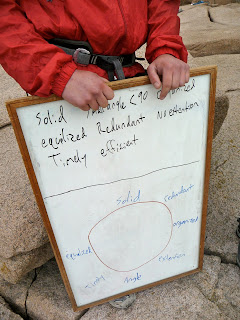Holy Cow, it's been a few days since our last installment! We have been really busy here at Acadia Mountain Guides. Our guides have been showing clients a good time hanging off the end of a rope, and we just completed a Professional Climbing Instructors Association (PCIA) Top Rope Site Manager and Single Pitch Instructor course. The season has begun and we here at AMG are psyched for a great summer.
Every June AMG provides a PCIA Top Rope Site Manager and Single Pitch Instructor course. The purpose of the courses is to teach new methods of rock climbing instruction and solidify existing skills.
At four days long, this course starts at the basics. What is a belay device, what is a rope, what is a harness? Now, most climbers new and old can answer at least one of these questions. The idea is to start simple. Most climbers know what a belay device is, but could most climbers effectively teach a person what a belay device is and how to properly use it? Maybe.
| Look at all the different belay devices! Being a good instructor means being able to explain how they are different and why you might choose one device over another. |
As the course goes on we start to shift gears to understanding knots, placement of protection and the construction of climbing anchors. Believe it or not there are only a few basic knots a climber needs to know to be proficient. However, an instructor should know more and be able to explain how the knots are constructed.
Think about the movie Jaws. Remember Hooper trying to tie a bowline around a barrel before Quint shoots the shark with a harpoon? Well, if Hooper had taken a PCIA course he would have been able to tie that bowline with a bit more confidence and wouldn't have almost kill Chief Brody in the process.
There are many different ways to tie specific knots. What's important is the end product. A bowline should be a bowline no matter how you decide to tie it.
So is there a difference between any of these knots? They all look like bowlines…
 SOLID/SIMPLE
SOLID/SIMPLEEQUALIZED
REDUNDANT
NO
EXTENSIONS
The anchor you build should fit into each criteria. However, the important thing to remember is that all parts of a good anchor are built on each other. You can't limit your Extensions without thinking about Equalization. You wouldn't have anything to Equalize without thinking about Redundancy.
Unfortunately, there is so much more to say about the PCIA course and Acadia Mountain Guides in general but, alas, there is only so much time say it.
I will leave you with this:
If you haven't made it to Acadia National Park yet this year, get here FAST! The weather is warm and sunny with cool ocean breezes. The rock is dry and begging to be climbed! Take a week off from work, finish up school and come out here! You won't regret it!
Be sure to stop in atour Bar Harbor shop at 228 Main St. and say hello!
ANDE KAHORA
